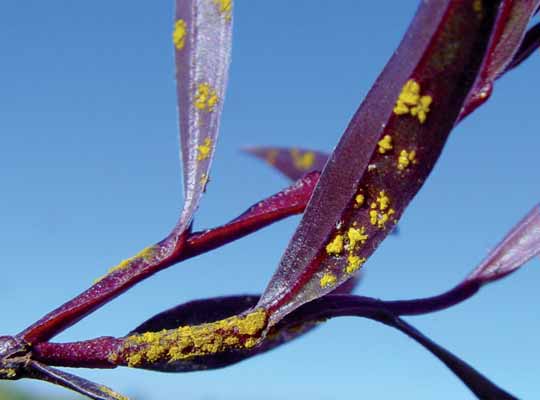PESTS AND DISEASES OF FORESTRY IN NEW ZEALAND
Getting aggressive with myrtle rust
From Biosecurity 100, October 2010
Myrtle rust (Uredo rangelii), a fungal pathogen part of the guava rust disease group, has caused severe economic damage to the plant family Myrtaceae in many parts of the world.
Earlier this year, Australian officials reported myrtle rust had been detected for the first time on three species of Myrtaceae at five commercial cut flower nurseries within a few kilometres of each other in New South Wales.

Initially, Australian officials opted for a management approach as they did not believe eradication of the rust was possible. However, a decision has since been made to take a more aggressive approach and in July this year an Interim Response Plan, described as suppression with a view to eradication, was put in place. Under this plan, Australia will carry out host destruction, spore trapping, diagnostic research and host testing.
Information obtained so far has expanded the number of detections by five additional host plants. Of the eight plant species now affected by myrtle rust, the most severe infestation has been reported on Australian natives Agonis, Tristania, and Austromyrtus. MAF Biosecurity New Zealand (MAFBNZ) is seeking detailed information from Australian officials regarding these new detections.
MAFBNZ currently prohibits, or is in the process of prohibiting, importation of host material from Australia in line with known hosts from other areas with guava rust. The number of export shipments of Myrtaceae cut flowers and plants (for planting) from Australia to New Zealand has been small over the past decade, so changes to the import requirements for Australia will have a limited effect on trade.
If the rust spores build to sufficiently high levels in Australia, they could arrive here via various pathways, including wind currents. A number of other rusts are believed to have arrived in New Zealand in this manner. Early detection of myrtle rust here would be difficult due to the widespread nature of the numerous hosts, and the difficulty of predicting where exactly any windborne rust spores may land. Any impact on New Zealand flora and fauna will depend on which species here become infected, as both the host range and impacts of this rust complex are highly variable and currently unpredictable making forward planning difficult.
New host genera within Myrtaceae are often discovered only when the rust has spread to a new location. A number of species significant to New Zealand are either known to be, or are, potential hosts for this rust complex. Two New Zealand species of Metrosideros (pohutukawa and Kermadec pohutukawa) have already been infected by guava rust in Hawaii.
New Zealand has one native species in the highly susceptible genus Syzygium, plus four other Myrtaceae genera, including Leptospermum (manuka). Apart from eucalypts and native species, ornamental plantings in New Zealand are likely to be infected by the rust. Feijoa is a reported host and Agonis flexuosa, one of the species affected in Australia.
While the likelihood of the entry of myrtle rust within the next five years is high, so too are uncertainties about host range and species impact. MAFBNZ officials are closely monitoring the Australia situation to decide on the most appropriate preparedness steps for New Zealand.
Dan Fieselmann, Senior Advisor Plant team, MAFBNZ. dan.fieselmann@maf.govt.nz

 Farm Forestry New Zealand
Farm Forestry New Zealand

